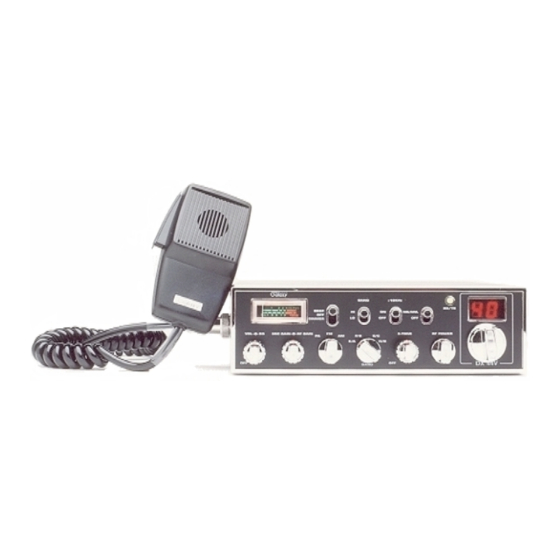Galaxy DX 44V Kullanıcı El Kitabı - Sayfa 7
Alıcı-Verici Galaxy DX 44V için çevrimiçi göz atın veya pdf Kullanıcı El Kitabı indirin. Galaxy DX 44V 9 sayfaları. Full channel am/fm mobile transceiver

PRESS-TO-TALK MICROPHONE
The receiver and transmitter are controlled by the press-to-talk switch on the
microphone. Press the switch and the transmitter is activated, release switch to
receive. When transmitting, hold the microphone two inches from the mouth and
speak clearly in a normal "voice". The radios come complete with low-impedance
(500 ohm) dynamic microphone. For installation instruction on other microphones,
see next section, "ALTERNATE MICROPHONES AND INSTALLATION".
OPERATING PROCEDURE TO RECEIVE
1. Be sure that power source, microphone and antenna are connected to the
proper connectors before going to the next step.
2. Turn unit on by tuning VOL control clockwise on your transceiver.
3. Set the VOLUME for a comfortable listening level.
4. Set the MODE switch to the desire mode.
5. Listen to the background noise from the speaker. Turn the SQUELCH control
slowly clockwise until the noise JUST disappears (no signal should be
present). Leave the control at this setting. The SQUELCH is now properly
adjusted. The receive will remain quiet until a signal is actually received. Do
not advance the control too far, or some of the weaker signals will not be
heard.
6. Set CHANNEL selector switch to the desired channel.
7. Set the RF gain control fully clockwise for maximum RF gain.
OPERATING PROCEDURE TO TRANSMIT
1. Select the desired channel of transmission.
2. Set the MIC GAIN control fully clockwise.
3. If the channel is clear, depress the push-to-talk switch on the microphone and
speak in a normal voice.
- 11 -
ALTERNATE MICROPHONES AND INSTALLATION
For best results, the user should select a low-impedance dynamic type
microphone or a transistorized microphone. Transistorized type microphones have
a low output impedance characteristic. The microphones must be provided with a
four-lead cable. The audio conductor and its shielded lead comprise two of the
leads. The fourth lead is for receive control, and the third is for transmit control.
The microphone should provide the functions shown in schematic below.
4 WIRE MIC CABLE
Pin Number
1
2
3
4
Fig. 1 Your transceiver microphone schematic.
If the microphone to be used is provided with pre-cut leads, they must be revised as
follows.
1. Cut leads so that they extend 7/16" beyond the plastic insulating jacket of the
microphone cable.
2. All leads should be cut to the same length. Strip the ends of each wire 1/8" and
tin the exposed wire.
Before beginning the actual wiring read carefully, the circuit and wiring
information provided with the microphone you select. Use the minimum head
required in soldering the connections. Keep the exposed wire lengths to a minimum
to avoid shorting when the microphone plug is reassembled.
Mic Cable Lead
Audio shield
Audio Lead
Transmit control
Receive Control
- 12 -
